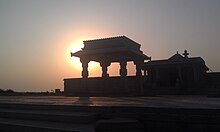User:Doc.aneesh/sandbox
| Venugopala Swamy Temple | |
|---|---|
 Entrance to the temple complex | |
| Religion | |
| Affiliation | Hinduism |
| District | Mandya |
| Location | |
| Location | Hosa Kannambadi, Near Krishna Raja Sagara |
| State | Karnataka |
| Country | India |
| Geographic coordinates | 12°26′40″N 76°34′04″E / 12.44444°N 76.56778°E |
| Architecture | |
| Type | Hoysala architecture |
The Venugopala Swamy Temple located at Hosa Kannambadi, Near Krishna Raja Sagara, is another example of Hoysala architecture in Karnataka. This temple was built in the 12th century AD around the same time as the Chennakesava Temple at Somanathapura, Mysore district.

Original location[edit]
Before the Krishna Raja Sagara dam project was conceived by Sir M.Visvesvaraya in 1909, the temple complex was located in the village of Kannambadi. The KRS Dam project meant that Kannambadi and other surrounding settlements would be submerged. The then king of Mysore, Krishna Raja Wadiyar IV ordered the construction of a new village for the residents of Kannambadi and aptly named it Hosa Kannambadi (New Kannambadi).[1]
However, the Venugopala Swamy temple complex and 2 other temples namely Kenneshwara (Ishwara) temple and Kalamma (A local diety) temple had to be abandoned. By 1930, the first phase of the dam was completed and all three temples were submerged.[2]
The main idol of Venugopalaswamy, Lord Krishna playing on flute as a cow-herd, was shifted to a new temple in the rehabilitated village before the submersion.[3]
Architecture[edit]
The original temple complex was massive, with an area of around 50 acres (100 x 60 yards)[4]
The complex was a symmetrical building enclosed by two 'prakaras' and the outer gate (Mahadwara) had verandahs on both sides, flanked by the yagasala and the kitchen. This was enclosed by the second mahadwara, which led to the inner enclosure and was akin to the Somanathapura temple.
It had altogether 46 constituent shrines - 17 each on the southern and northern sides and 12 on the western side, all of which were embellished with 24 murthies or idols and ten incarnations of Lord Vishnu, besides the figures of Brahma, Saraswathi, Harihara, Hayagriva and Jalasayana. The temple had a garbhagriha (sanctum sanctorum), a vestibule, a middle hall and a mukhya mantapa (main hall). The cell opposite to the entrance had a figure of Kesava (Lord Krishna) and the south cell, containing the figure of Gopalakrishna, was a later addition[5]
Submersion and Restoration[edit]
When the KRS dam was conceived in 1909, the temple was condemned for submersion. By 1930, the entire erstwhile village of Kannambadi was completely buried underwater. However, the temple would resurface whenever the water levels in the reservoir dropped, typically during drought years. This was most evident around the year 2000. [6]
For more than 70 years the temple lay underwater, when the Khoday Foundation under the guidance of liquor baron and philanthropist Mr. Sri Hari Khoday took up the mammoth task of relocating and restoring the temple. It was initially planned to shift the entire complex to 'Madhuvana Park' in Mysore. However, protests from the villagers of Hosa Kannambadi convinced the foundation to shift it to a place near the rehabilitated village. The cost of the project was estimated to be around ₹ 2.5 crore [7]
The new site is about one km to the north of the original site, the backwaters would touch the outer walls of the temple if the water level of the KRS touched 124.80 ft, its maximum capacity[8]
The in-house architects of the group had shot the original temple on video, taken over 16,000 photographs, and had marked each and every slab used in the construction of the original temple. [9] Each and every temple stone was removed and reconstructed at Hosa Kannambadi with trained artisans and sculptors from Madurai and Thoothukudi from Tamil Nadu and Pondicherry working round the clock to recreate the magic of their predecessors.[10]
As of December 2011, the temple restoration has been completed, but is awaiting an official inauguration. It however has become a tourist hotspot considering it's tale of submersion and relocation[11]
Gallery[edit]
- Venugopalaswamy Temple Gallery
-
An inscription written in halegannada seen at the entrance
-
Outer wall of the Venugopalaswamy temple
-
Entrance to the complex from the East
-
A View of the KRS reservoir from the temple entrance
-
Deepa Sthambha (Lamp Post) used to light up the entrance at night
-
Typical Hoysala architecture of the Venugopalaswamy temple
-
Venugopalaswamy temple Gopura
-
Venu Gopala Swamy Temple from the front
-
Venu Gopala Swamy Temple from the front
-
Sunset overlooking Krishna Raja Sagara as seen from the Venugopala Swamy temple
References[edit]
- ^ "Venugopalaswamy Temple".
- ^ "Relocation of Krishnarajasagar Venugopalaswamy Temple". MysoreSamachar.com.
- ^ "Submerged temple's reincarnation almost complete". One India News.
- ^ "Submerged temple's reincarnation almost complete". One India News.
- ^ "Submerged temple's reincarnation almost complete". One India News.
- ^ "Sri Venugopalaswamy Temple reconstruction in progress near KRS".
{{cite web}}: Unknown parameter|Publisher=ignored (|publisher=suggested) (help) - ^ "Liquor baron Khoday Kick-starts KRS temple shifting". OurKarnataka.Com.
- ^ "Relocation of Krishnarajasagar Venugopalaswamy Temple". MysoreSamachar.com.
- ^ "Restoration of Gopalakrishna Temple under way".
{{cite web}}: Unknown parameter|Publisher=ignored (|publisher=suggested) (help) - ^ "Relocation of Krishnarajasagar Venugopalaswamy Temple". MysoreSamachar.com.
- ^ "For the offbeat traveller". The Hindu.
External Links[edit]
Category:13th-century architecture
| Part of a series on |
| Hinduism |
|---|
 |












